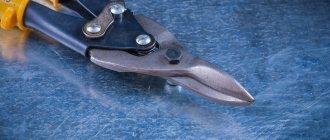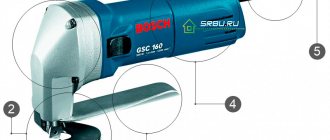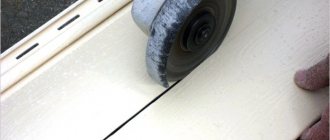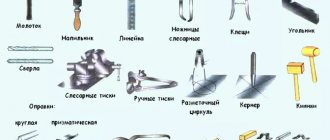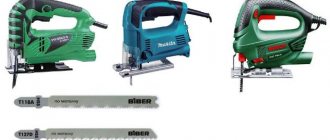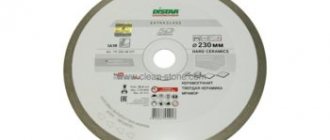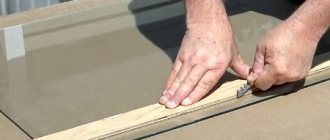General classification
Modern tools for cutting steel, iron, and other metals cope with material of any thickness. This is due to the variety of shapes and types of products, divided into several groups according to characteristics, including:
- cutting principle;
- principle of operation.
According to the cutting principle, metal scissors are:
- knife;
- die-cutting (notching).
Based on the principle of operation, they are distinguished:
- manual (mechanical);
- electric scissors.
Cutlery is a “classic of the genre.” They have two single-edged knives and cut metal only from the edge of the sheet. Nibblers work on the principle of hollowing out material and are more often used for profiled or corrugated sheets. With their help, metal is cut from the middle of the workpiece.
Knifes are divided into several groups:
- in the cutting direction (left/right);
- according to the shape of the cut (straight/curved).
Products with a right-hand cut have a marking line to the right of the cutting edge; scissors with a left-handed cut are the opposite. Cutting metal with scissors is carried out according to the applied markings, with the upper blade located above it. Straight metal scissors cut the workpiece strictly in a straight line, while curly ones allow you to maneuver and obtain products of unusual shapes.
Metal nibblers
Now let's take a closer look at hand scissors for cutting metal. They are more common than others, and the classification is supplemented by several subspecies.
Metal shears: general classification
Modern metal cutting scissors can handle both thin-sheet and thick materials. They are divided into many types and types and differ in both appearance and application.
Professional metal scissors are classified according to several criteria. By cutting type:
- Knife. They, in turn, are classified according to the cutting direction into left and right. And according to the shape of the cut - into curves and straight lines.
- Die-cut.
By degree of mechanization:
- Manual.
- Electrical.
Types of hand scissors for metal
The task of the tools in question is to cut workpieces using human physical strength. The group includes:
- ordinary;
- lever;
- roofing (chair);
- hydraulic;
- disk (roller);
- sheet metal scissors.
VIEW Sheet metal cutting shears on AliExpress →
Chair scissors
Lever metal shears
In conventional models, the cutting edge and handle are made of the same material by forging. The efficiency of the tool is affected by the applied force, the length of the cutting edge, and the length of the handle. Conventional hand metal shears are divided into:
- pass-through (straight cut);
- curly (curvilinear);
- ideal (universal; cuts both straight and curved).
Lever metal shears differ from the above mentioned ones in that they have a hinged connection between the cutting edge and the handle. This creates an additional lever that facilitates the work of the master. The required force to cut the workpiece is less, and the quality of work does not suffer. They have one drawback - they don’t work without being attached to a workbench.
For materials of medium thickness (2-4 mm), roofing devices are used. The design allows them to be attached to a mechanic’s workbench so that the master spends less physical effort. The name indicates the compatibility of the tool for cutting profiled sheets (used for roofing) and similar products of complex shape.
It is important to know that among manual devices there are no die-cut ones. The remaining types of scissors have a complex design and therefore require separate consideration.
Hand scissors for metal
Now let's take a closer look at hand tools. It includes all those devices that require human physical strength to operate.
This is a large subgroup of a wide variety of tools, among which the following types of scissors can be distinguished:
- Regular. They are made with straight, curved or combined blades. Designed for cutting sheets of steel and non-ferrous metal up to 1.5 mm thick.
- Lever. Attached to the workbench. The blades are connected to the handle by a hinge, which creates additional leverage and makes work easier. The tool cuts sheets up to 2.5 mm thick.
- Chair or roofing. One handle is clamped in a vice or driven into a rigid base, which provides greater compression force. You can cut profiled sheets up to 2.5 mm, but this tool is unproductive and inconvenient.
- Hydraulic. This is a separate group of cutting tools. Hydraulic shears are divided into manual (compact, portable devices for cutting cables and fittings up to 20 mm thick) and large (mechanisms that are attached to the base machine, and with the help of which they dismantle metal structures and dispose of old cars, boats, trains, etc.) .
- Roller shears. They are also called disk ones. The design uses circular knives as the working part, which cut metal when rotated. Usually in such models there are 2 rollers - one on top and one on the bottom, and the workpiece is fed between them.
If the rollers are parallel, the tool is designed to cut sheet metal into strips. If one disk is inclined, then the device is used for cutting ring and disk blanks. If both rollers are inclined, then the scissors are designed to work with disks and circles of small radius.
Features of hydraulic products
The products are designed for cutting metal structures (rods, profiled iron, scrap, fittings) using an evenly distributed force along the length of the blade. Conventionally divided into two groups:
- small-sized;
- large-sized.
Hydraulic shears are actively used by rescue services
The first ones are also called manual. For example, the following are manual hydraulic shears NGR-20 “KVT”. Their purpose is to cut armored cables, fittings, and steel ropes. The main characteristics include:
- permissible thickness of the cut product is 20 mm;
- high-strength cutting blade (60-62 on the Rockwell scale);
- maximum force - 5 t;
- length - 36 cm, weight - 3.2 kg;
- the presence of a rotating guillotine type head;
- addition of a pressure release lever to the design;
- cost about 20 thousand rubles.
VIEW Hydraulic Shears on AliExpress → Large tools are bolted onto the base machine. Intended for:
- scrap metal cutting;
- recycling of cars, buses, trucks;
- dismantling of metal structures;
- cutting and recycling of rolling stock;
- cutting of boats, ships, boats.
Impressive hydraulic shears for cutting metal are available in several series. For example, AD class models dismantle steel structures, MP-T is suitable for longitudinal cutting of metal (sheet), DS for reinforced concrete, and so on.
Disc tool features
Disc shears, also known as roller shears, are a more advanced design. The working bodies are roller knives, which, when rotated in different directions, are pressed into the workpiece and cut it. Mutual friction between the metal and the disks causes the sheet to move along the tool.
Roller metal shears
Typically, disc shears have two rollers - top and bottom. Their relative arrangement is of three types:
- parallel;
- with one inclined roller;
- with both inclined rollers.
Manual circular shears with a parallel position of the working parts are used for cutting metal into strips. The second group is used when working with ring or round workpieces. The third is for them, but with a small radius.
The distinctive properties of the tool are its speed of operation and the absence of the need for additional processing of the cut edge. In addition, roller shears for cutting sheet metal cost in an acceptable range from 20 to 40 thousand rubles, thanks to which they have become very popular among consumers.
Sheet scissors. Design and technical characteristics of sheet shears
EXPERIMENT FROM BIZOOMIE.COM: BINARY OPTIONS TRADING
Investments in Internet business: results of the second month
Investments in Internet business: +13,900 rubles for the first month
| Publications | 1 119 | 03/08/2014
Cutting a rigid metal sheet places special demands on the tool - it must be durable, reliable and safe, provide an even cut and not have a negative impact on the sheet, leading to a deterioration in its technical and operational parameters. All these conditions are fully met by hand-held sheet shears, which:
- Easily handles metal of any thickness;
- give an even and neat cut exactly at the marking location;
- completely safe at work, without creating a threat to human health and life;
- simple and accessible to use;
- produce a minimum amount of waste, contributing to the economical use of metal;
- are presented in a wide range, allowing you to select a device depending on the characteristics of the sheet metal used.
The only limitation when working with sheet metal scissors is the ability to carry out straight cutting only from the edge of the sheet, while cutting out a complex shape or starting work from the middle of the roll is not possible. However, this drawback has virtually no effect on the scope of application of scissors, which are today used at the initial stage of metalworking.
Technical device and operating parameters of sheet metal shears The main indicators that need to be taken into account when choosing sheet metal shears are:
- power - determines the performance of the device and its ability to work with dense metal sheets;
- number of strokes – determines the cleanliness and speed of the cut;
- minimum cutting radius – allows you to cut along an oblique line;
- maximum thickness – allows you to select a tool depending on the thickness of the sheet;
- weight – determines the ease of use and the way the scissors are placed on the work surface.
The main design elements of sheet metal shears are a housing with a motor and a housing with a cutter head. The upper knife is driven, the lower one is firmly fixed to the bracket and remains motionless during the cutting process. By moving the bracket, you can change the gap between the planes of the lower and upper knives, adapting them for cutting metal of different thicknesses.
The principle of operation of manual sheet scissors is completely similar to that of their stationery counterpart. Moving up and down, the upper knife makes a cut without burrs, and the edge of the metal and the applied decorative or protective coating remains smooth and does not deform.
- Like
- Retweet
- Like
Also on this topic:
5 ways to become a millionaire in a big city
Business options with minimal investment
Business ideas 2014
Add a comment Cancel reply
You must be logged in to post a comment.
Features of Sheet Shears
The operating principle is reminiscent of conventional household analogues.
A static knife is mounted on a rigid support, and a movable knife is mounted on a perpendicular plane. The support zone is adjustable, allowing the user to select the desired gap between both blades to suit the thickness of the workpiece. Sheet metal shears cut the workpiece only from the edge; from the middle the design will not allow. Shaped cutting is also difficult to achieve.
The demand for products is due to the correct ratio of the thickness of the sheet being cut and the cost. For example, sheet metal shears Makita BJS160Z cost about 10 thousand rubles, and have the following characteristics:
- maximum cutting thickness for steel - 1.6 mm, aluminum - 2.5 mm;
- minimum cutting diameter - 0.5 m;
- battery power;
- stroke frequency - 4300/min.
This tool is sufficient for standard home and garage work.
Domestic manufacturers offer products with similar parameters and lower prices. For example, sheet metal shears Caliber-Master ENN-500 with a maximum cutting thickness of 2.5 mm will cost the consumer 4 thousand rubles. However, user reviews indicate that foreign manufacturers (Makita, Bosch, Metabo and others) supply more reliable equipment to the market.
VIEW Makita Sheet Shears on AliExpress →
Overview of scissors and basic rules of care and operation
What scissors should you buy before starting your sewing journey? Some, many, what are they all for? In this article we will talk about a basic set for beginners and list the basic rules for caring for scissors.
So, scissors are different. There are 3 types just for working with fabric:
- Cutting scissors with a large angle of inclination of the handles in relation to the blades. Due to this design, they lift the fabric above the table less than other models, therefore, allowing for more accurate cutting.
- Tailor's scissors are needed to perform various types of sewing work at the stage of sewing a product.
- Universal scissors combine the best qualities of tailor's and cutting scissors. If you sew for pleasure, choose this option.
We recommend including the following items in the minimum set of scissors:
- tailor's/universal;
- stationery;
- snippers (scissors with springs for cutting threads).
At Vikisews we have 7 scissors in our arsenal, which we use regularly:
- Universal scissors for dense and thick materials. Massive, solid, with long blades and a screw fastening. We use it for cutting brushed footer, coat and thick suiting fabrics.
- Universal scissors for thin materials. Lighter than the previous model, the blades are shorter and sharpened more thinly. We cut silk and chiffon.
- Stationery scissors with a comfortable handle and sharp tips. They are convenient for working with patterns, as well as cutting braid, zipper, tight cord, and plastic regilin.
- Snippers.
- Zigzag scissors for processing cuts.
- Craft scissors are an ideal option for cutting out appliqués and trimming seam allowances when processing with a Moscow seam.
- Embroidery scissors with narrow blades for hard-to-reach places that cannot be reached with large scissors. For example, for cutting loops.
Fabric scissors are a highly guarded form of wealth. They are made of special steel, have a special shape and sharpening angle of the blade and quickly become dull if they are:
- use for other purposes;
- use when working with sequin fabric, fabric embroidered with beads (if you sew often, it’s better to have separate scissors for this type of material);
- stored incorrectly.
To ensure that scissors serve for a long time, do not neglect the operating rules:
- store in a dry place;
- lubricate the fastening screw with sewing machine oil;
- wipe the blades with a dry cloth after each cutting;
- keep closed;
- sharpen in a timely manner.
By the way, about sharpening. Tailor's scissors should only be “supervised” by a professional, since if the technology is violated, the scissors will cut the fabric unevenly and quickly become dull. The whole point of professional sharpening is that the blade must be sharpened evenly and at a certain angle. Technically, this is only possible with the help of a special machine that securely fixes the scissors.
Although there are always a couple of tricks to sharpen the scissors a little without harm and a professional!
- Cut the very fine sandpaper into thin strips.
- Chop up a metal (or used) sponge (almost every kitchen has these).
- “Unravel” the foil into ribbons, after folding it several times.
The methods, fortunately, are harmless, but, unfortunately, ineffective. They are suitable if you need them right now and literally for one cutting. Then go to the master.
Independent production of products
Since cutting metal with hand shears is so easy, some craftsmen don't see the point in buying expensive equipment. This is especially true for roller models - expensive and attractive. However, it is not difficult to make homemade metal scissors if the material of the knives is a durable alloy, the strength of which is higher than that of the material being cut.
It is common to use bearings as rollers. Their ends are pre-sharpened. The drive roller is fixed to the handle, with pressure on which the tool is pressed into the workpiece. Next, the user only pulls the sheet of metal towards himself, keeping the handle pressed to the base.
No matter how easy it may seem to make metal scissors with your own hands, it is not recommended. Equipment from well-known brands will ensure safe operation when cutting workpieces and will last longer. In addition, there are models on the shelves that do not require additional units for operation (homemade lever scissors for metal, for example, work only in conjunction with a machine).
Tips for choosing
Before purchasing, the consumer studies the characteristics of the tool:
- power;
- battery capacity (when selecting class models);
- ergonomics;
- maximum metal thickness;
- maneuverability;
- protective functions;
- execution of the starting unit;
- functionality of cutting parts.
The user must remember the safety precautions and check the serviceability of all components of the unit before starting work. When using electric shears, give them breaks to allow the motor to cool down.
The above classification of products for cutting metal blanks will help novice craftsmen navigate the variety of existing models.
